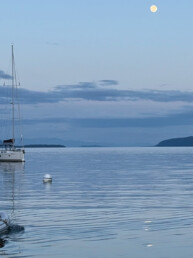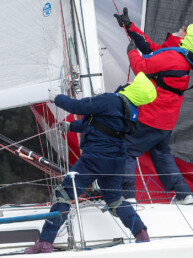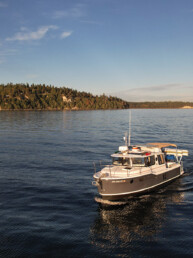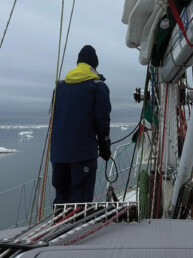The infamous Double Damned brings sailors to the notoriously windy Columbia River Gorge for what’s supposed to be a 40-mile downwind rip full of planing, wipeouts, and as much fun as you can have on a sailboat.
The forecast for this year’s Double Damned was uncharacteristically light. We delivered our J/70 Spitfire up from Hood River, which lies at the halfway point of the race course, the day before the race in 20-knot winds that had been forecast as 10-15, so we were hopeful that the next day would outperform predictions as well.
Saturday morning had a fleet of 16 boats that was mostly a mix of J/70s, Moore 24s, and Wylie Wabbits, preparing for a 10 a.m. start. Unfortunately, 10 a.m. arrived with dead calm conditions. We remained under postponement until we had a breath of breeze fill in across the river just after 11:00, and the race committee called for a warning at 11:30.
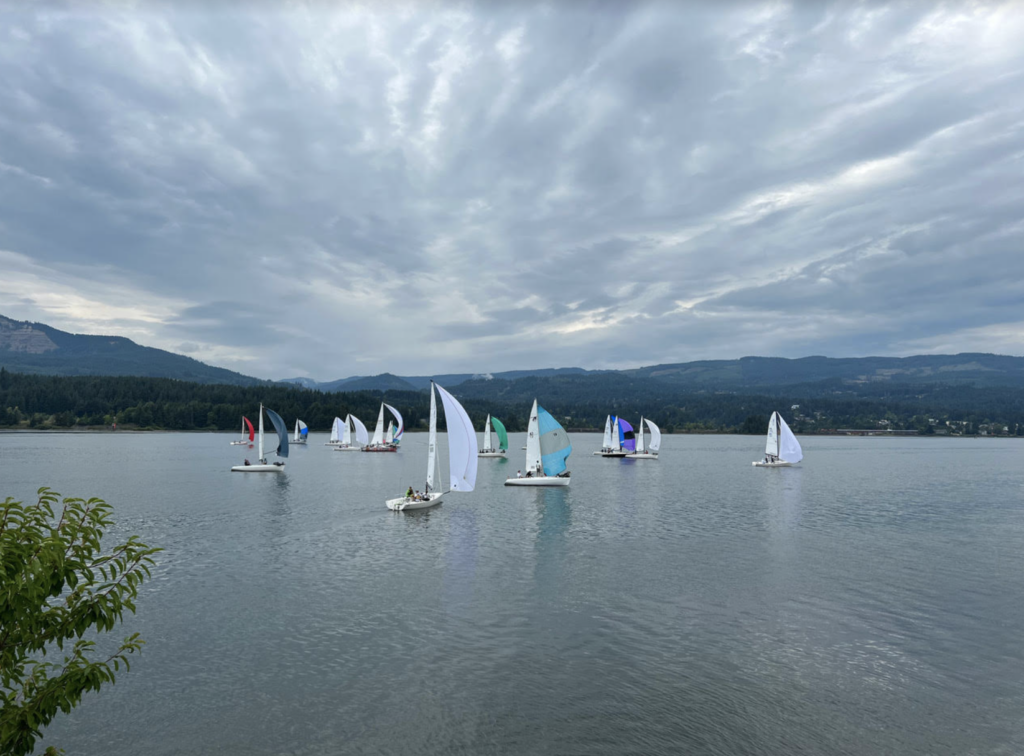
Aboard Spitfire, we found ourselves slightly behind at the downwind start in only about 5 knots of breeze, forcing us to navigate through the group of symmetrically rigged Moore 24s looking for the windiest patches on the river. After more than a dozen jibes in the first 30 minutes of the race, we found ourselves getting a bit of separation from the Moore fleet and clear to jibe more freely.
Two boats — Morgan Larson’s Moore 24 Bruzer and Matt Laffitte’s J/70 Lift Ticket — had opted to hug the Oregon shore for current relief, and made out well until the breeze on that side of the course evaporated and they were forced out to the middle of the river where they crossed behind the lead boats that had opted to go up the middle. Both aimed across to the Washington shore, presumably looking to get out of the current again but with more wind.
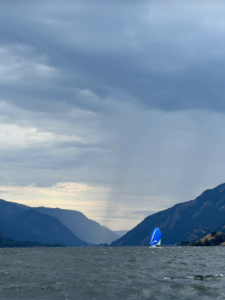
In the span of a few minutes, the wind shut down and the river turned to glass. Two J/70s, Lift Ticket and Andy Mack’s Awkward Turtle, managed to stay in the last of the breeze and build a substantial lead before they lost their wind as well, but they ended up half a mile ahead of the next few boats. Marcos McGee’s Wabbit FAFO managed to ghost along the shore in what appeared to be no breeze at all with a full kite to come from behind past mid-fleet until they finally lost their magic puff and the whole fleet sat becalmed.
The calm lasted for an hour and a half. Some boats that were close to shore set anchors. We hadn’t prepared for this and without an anchor, slowly drifted back down the river with the current. Everyone ate lunch and many crews went for a swim. FAFO were the first to call in their retirement over the radio. We knew that once one boat decided to call it, others were sure to follow, and as we sat, nearly half the fleet retired. We set a 3 p.m. time limit — if there wasn’t wind by then, we were going to dig out the motor and head in, too.
At 2:42, and at least 500 yards back from where we’d lost our wind, we saw the boats at the back of the fleet putting their kites up and bringing wind down towards us. We prepared to get back on track and a minute later we were cruising along at 3.5 knots. At this point we were over three hours and only five miles into a 40-mile race with an 8 p.m. time limit to finish. There was still the option to shorten course to the halfway point in Hood River and weather stations ashore were showing wind in the teens at Viento State Park eight miles ahead, so we knew there was wind up there somewhere. The wind pushed the back of the fleet up to the leaders causing a restart for the remaining nine boats, but somehow Lift Ticket managed to find their way out ahead early, and maintained that half-mile lead they’d built and extended it as they would be the first boat to the bigger breeze at Viento. It was now a race for second place for the other eight boats.
We traded jibes and connected puffs as best we could for the next hour and a half. At one point we went in towards the Washington shore just behind Awkward Turtle, who elected to jibe out. They ended up in a hole that they never recovered from and dropped out the back of the fleet, eventually retiring as well.
We slowly built a small lead over the Moores that were chasing us down until just west of Viento at around 4:30 p.m., we hit the promised wind — it was blowing 13-15 knots with gusts near 20! The race quickly changed pace as we were up on plane hitting boat speeds of 11 and 12 knots. As the first boat into the new breeze, we immediately began to extend our lead on the Moore’s but the remaining Wabbit was flying in these conditions and we crossed jibes with them several times running down the river. They seemed to sail straight downriver with their symmetrical kite and we jibed back and forth past them, each time hoping to cross in front. We took one jibe too far out to the Washington side of the river, and they got a lead of a dozen boat lengths that we then needed to claw back.
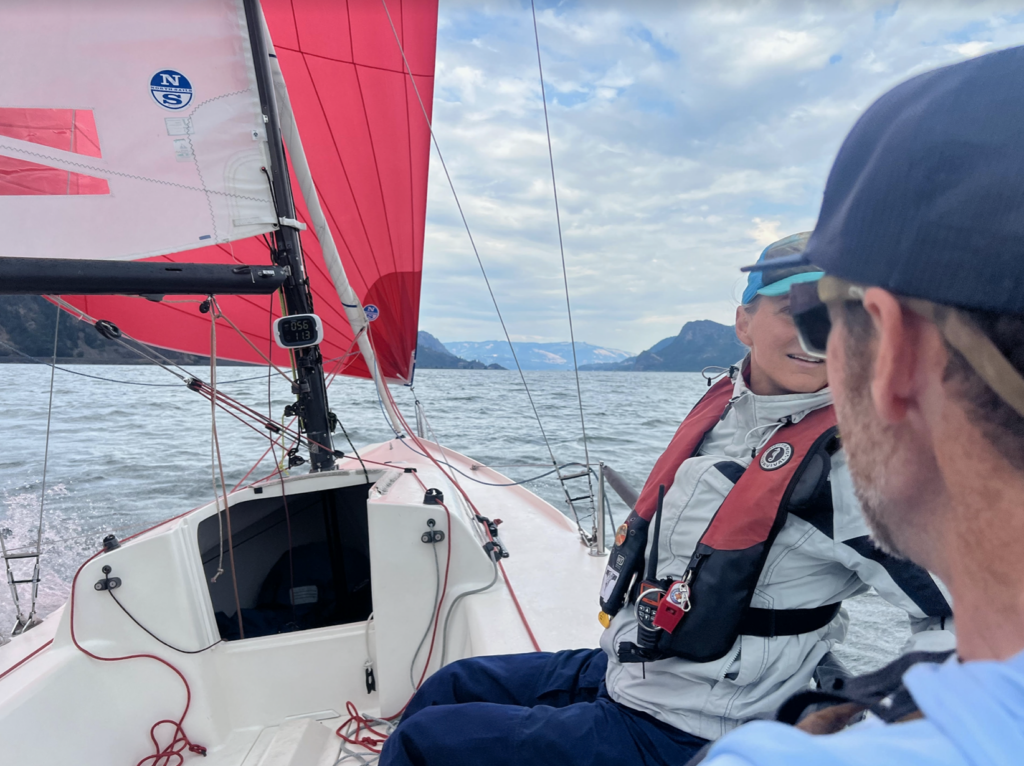
As we approached Hood River and the breeze eased back nearer to 10 knots, the Wabbit shot down the north edge of the river and we hugged the south side, trying to avoid the current. We made up most of the ground we’d lost and crossed under the Hood River Bridge, the shortened finish line, a couple boat lengths behind them and a few minutes ahead of a competitive Moore fleet.
On corrected time after 6 hours of racing on the shortened course, first place went to Matt Laffitte’s J/70 Lift Ticket, nearly 20 minutes ahead of us in second place on Spitfire, who beat out third place Michael Lazzaro’s Moore 24 Covfefe by a minute and a half.
Full results can be found here: www.regattanetwork.com/event/25381#_newsroom

